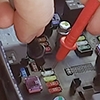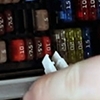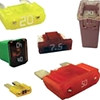Fuses melt (or blow) due to exceeding the permissible circuit load. This can occur because of various issues. Here we will discuss the most common typical issues.

-
Cigarette lighter socket
Contents
A cigarette lighter socket is often used as a power connector for various additional auto devices such as:
- radar detectors;
- navigators;
- air compressors;
- mobile charges;
- multi splitters;
- other car gadgets.
However, some of them may be of questionable quality. Moreover, if you plug in multiple devices simultaneously into the power socket, this can lead to current-carrying capacity excess.
-
Window washer
Fuse failure may be caused by water freezing into a washer reservoir and washer system tubes. Frozen water impairs electric pump drive. As a result, the amperage raises and a fuse blows. Therefore, to prevent such situations, it is necessary to replace water with an anti-freeze fluid in time.
-
Windshield wipers
A fuse may get out of order in the case wipers have frozen to a windshield, as gearbox jams.
-
Defogger and rear view mirror heater
They may burn out due to wiring short circuit. The most “weak” wiring places are in front door corrugated hoses, trunk doors, and under a driver’s threshold overlay.
-
Heater
In case of heater electric motor wear, especially of bearings and bushes, the current in the electric drive circuit increases significantly. To avoid such situations, provide your heater fan with proper maintenance.
-
Lighting system
Fuses often blow in case of installing non-standard lamps, especially xenon short-arc lamps that have higher current consumption. When increasing the rated value, you need simultaneously to upgrade the lamp wiring. To achieve this, rewire your lighting system using cables of larger cross-section.
-
Engine cooling system
They get out of order when an electric fan’s current consumption increases. This may occur due to following reasons:
- foreign objects ingress into a fan blades rotation area;
- fan motors wear;
- engine lubrication depletion.
-
Engine control unit
Their fusion leads to an engine start failure. For this reason, a driver needs to know the location of fuses that serves an engine control unit. Almost half of all issues related to an engine start failure have the unit fusion to blame.
-
Electric power steering
The electric power’s drive consumes a high-amperage current. Therefore, at increased loads fuses often fail.
-
Electric parking brake
A parking brake electric drive is located in the “uncomfortable” place near wheels. Because of this, a unit’s integrity may deteriorate and moisture and dirt may get inside. As a consequence, an engine may jam that leads to fuses blowing.
-
Anti-lock braking system (ABS)
Due to pump wear, a current increases. So, this can lead to fuse blowing.
-
Central locking system, power windows
Central lock and power window drives often jam. As a result, fuses may blow. Besides, wiring fault and damage inside a corrugated hose of door wiring may also be to blame.



